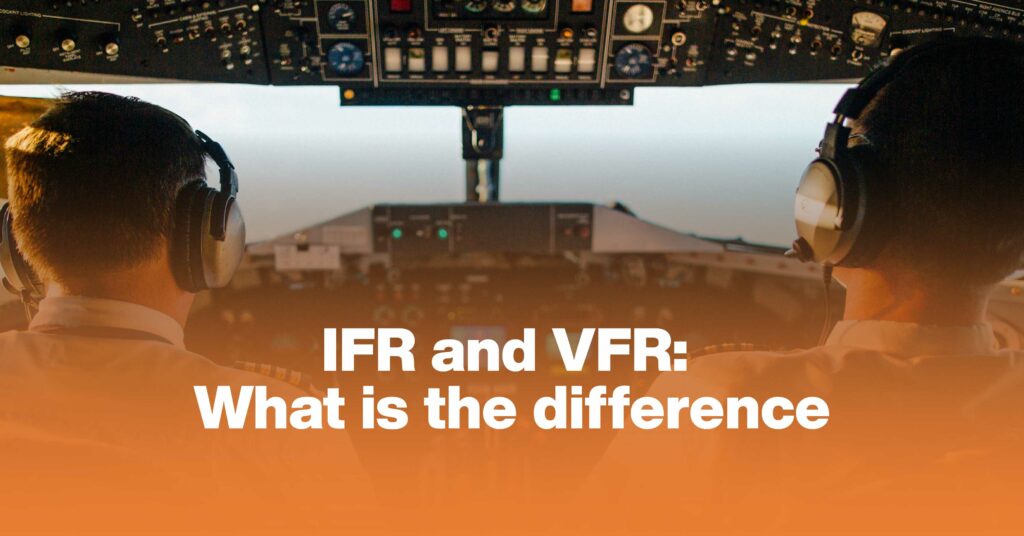There are two different ways that airplanes navigate. One way is by using the instruments. The other uses a much older instrument. The human eyeball, otherwise known as flying visually. Today, we will look at both methods as we discuss IFR vs. VFR flight.
What Is Instrument Flight Rules?
Instrument flight rules are rules and regulations to govern flight under conditions in which flight by outside visual reference is not safe. IFR flight depends upon flying by reference to instruments in the flight deck, and navigation is accomplished by reference to electronic signals.
Its Advantages:
- IFR allows the pilot to fly safely into lower weather minimums.
- Implementing an IFR program increases the safety margin and allows better EMS service to the community.
What Is Visual Flight Rules?
Visual Flight Rules simply means that the aircraft is intended to operate in visual meteorological conditions (VMC, i.e. nice and clear weather). Clouds, heavy precipitation, low visibility, and otherwise adverse weather conditions should be avoided under VFR.
Visual flight rules flying is only allowed when the weather is good enough for pilots to clearly see where they are going. All of these rules and regulations are taught to every new private pilot.
It’s Advantages:
- Flying VFR is less restrictive than flying IFR. Making reference to charts, pilots flying VFR can either plan a flight, or just fly where they feel like (as long as they don’t break any rules such as infringing airspace).
- VFR flight can benefit by Providing helpful information and assistance in the event of an emergency such as vectors to the nearest airport.
IFR VFR Difference:
In IFR, the aircraft is maneuvered and navigated with sole reference to the aircraft instruments. There is no requirement to be visual with the ground or even with the horizon.
VFR refers to flying using primarily visual references. When flying VFR, the general principle of ‘see and avoid’ is of paramount importance regarding other air traffic, especially in busy airspace.
- Weather Conditions
- Depending on the weather conditions a pilot may opt for one set of rules or the other. Mostly, it’s the weather that makes the pilot fly VFR or IFR.
- IFR requires a ceiling less than 1,000 feet above ground level (AGL) and/or visibility of fewer than three miles. VFR requires a ceiling greater than 3,000 feet AGL and visibility that’s greater than five miles.
- Navigation
- In a VFR flight, the pilot primarily controls and navigates the aircraft using outside visual references.
- In IFR, the aircraft is flown using only the instruments with no visual references to the outside.
- Flight Rules and Regulations
- For VFR, there must be no cloud within 1500 metres horizontally or 1000 feet vertically from the aircraft, and the “flight visibility” (the distance forward the pilot could see from the cockpit in flight) must be at least 8 km.
- Training and Certification
IFR Minimum requirements: 35 flight hours, 30 theory hours. The course consists of three stages and meets IFR training requirements. Each stage includes the required ground and flight training, followed by a stage check administered by the chief pilot or senior instructor.
Conclusion: Which Is Better, You Ask?
The answer to this question depends on who you ask—and when! The truth is that they’re both pretty amazing, but at different times. When the weather is good, and you’re flying in your own neighborhood, nothing beats a simple and fun VFR flight.
But when you’re traveling in new parts of the world, making long cross countries, or if the weather is a little low, the peace of mind and security that comes from being on an IFR clearance is hard to beat!
Frequently Asked Questions:
1. Can I Switch From VFR To IFR Or Vice Versa During A Flight?
Yes, a pilot can obtain a clearance to switch from IFR to VFR and vice versa while airborne.
2. Do I Need Additional Training To Fly Under IFR?
You must fulfill the following criterias for Instrument Rating:
50 hours of cross-country flight time as pilot in command.
Forty hours of actual or simulated instrument time, including 15 hours must have been received from an authorized instructor.
3. Can I Fly Under VFR In Adverse Weather Conditions?
To fly VFR, a pilot needs to see the horizon and use other visual cues to reliably maintain straight-level flight. Bad weather affects visibility it can make VFR pilots uncomfortable even when the conditions are still VFR-legal.
4. Are There Different Flight Planning Procedures For IFR And VFR Flights?
In a flight Plan, the following letters will denote the category of flight rules which the pilot intends to comply:
I when the whole flight will be under IFR
V when the whole flight will be under VFR
Y when the first part of the flight will be under IFR and later changed into VFR
Z when the first part of the flight will be under VFR and later changed into IFR.

